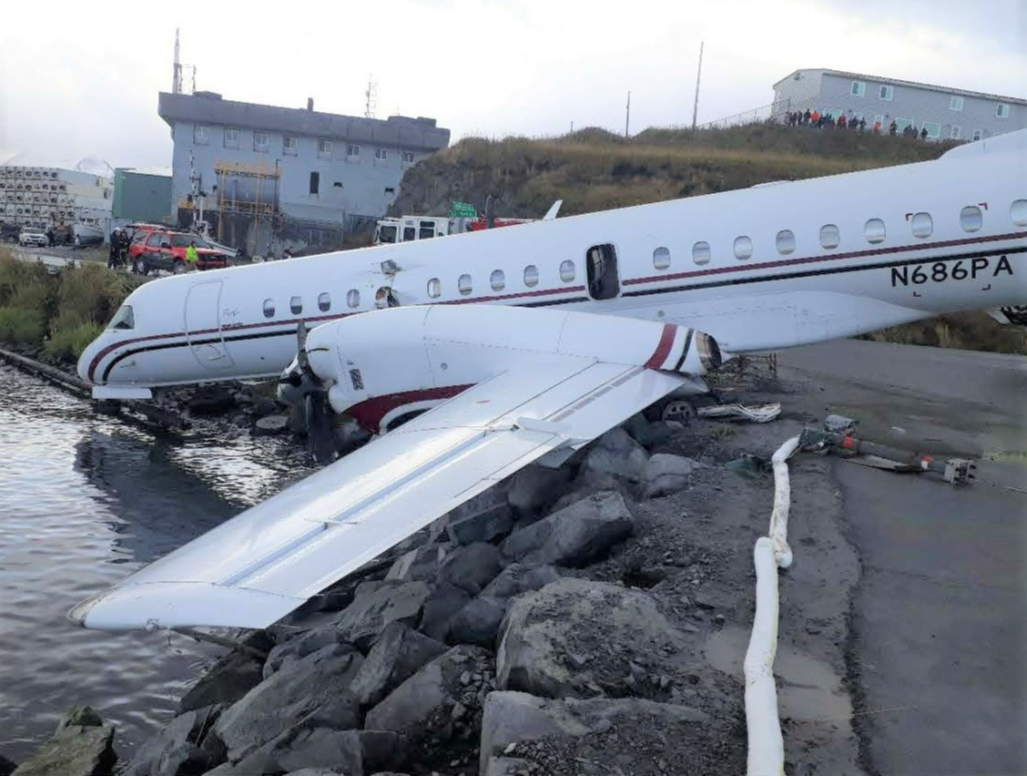Incorrect wiring on landing gear sensors was a top probable cause in the Oct. 17, 2019 runway overrun of a turboprop aircraft at Dutch Harbor, Alaska, that killed a passenger, according to the National Transportation Safety Board.
PenAir flight 3296 was a Saab SA-2000 carrying 39 passengers and three crew, when an attempted landing at the Unalaska airport ended with the aircraft overrunning the runway, crashing through the perimeter fence and across a road, and came to a stop on shoreline rocks at the edge of Dutch Harbor.
One passenger was killed; another was seriously injured; and eight sustained minor injuries, mostly during the evacuation. The flight crew, the flight attendant, and the other 29 passengers were uninjured. A resulting airport shutdown and days of flight delays caused some disruption at the start of the Bering Sea crabbing season.
The Peninsula Aviation Services pilots were making a second attempt to land on runway 13 despite learning “that a significant tailwind would be present during the landing,” according to an executive summary of the board report. “Because an airplane requires more runway length to decelerate and stop when a tailwind is present during landing, a landing in the opposite direction (on runway 31) would have favored the wind at the time. However, the flight crew continued with the plan to land on runway 13.”
NTSB investigators calculated that the tailwind was 15 knots at touchdown. The captain reported that initial braking of the aircraft was normal, but as the aircraft rolled down the runway it had “zero braking” despite the crew applying maximum brakes.
The aircraft braking system “was compromised by incorrectly wired anti-skid sensors,” the NTSB concluded at its Nov. 2 meeting.
“A post-accident examination of the airplane revealed sensors for the anti-skid system had been incorrectly wired during an overhaul of the left main landing gear,” according to a synopsis released by the NTSB. “This configuration led to the skidding and bursting of one tire and the subsequent release of brake pressure on two of the three remaining wheels. Investigators determined the loss of effective braking on three of the four main landing gear wheels prevented the flight crew from stopping on the runway.”
The report points to contributing factors, including the pilot’s decision to land with the tailwind, and federal aviation officials’ decision to allow Saab 2000 aircraft to use the Unalaska airport, considered one of the most challenging for pilots in the United States.
“Even though the airplane, the pilot, the weather and federal oversight all had a role in this tragedy, it was entirely preventable,” said NTSB Chair Jennifer L. Homendy. “The brake system should have been designed to protect against human error during maintenance, the pilot shouldn’t have landed on a runway with such a strong tailwind and federal regulators should have considered the runway safety area dimensions when authorizing the airline to fly the Saab 2000 into that airport.”
In their detailed documentation, investigators described how “wire harnesses for the left main landing gear wheel speed transducers were incorrectly routed; the harness that should have been routed to the left inboard wheel was instead routed to the left outboard wheel (and vice versa).
“As a result of the incorrect (crossed) wiring, the antiskid system performance was substantially compromised. Specifically, during most of the landing rollout, the left outboard tire was in a skid. However, because of the crossed wiring, the antiskid system perceived that the left inboard wheel was skidding and released the brake pressure to that wheel and the right inboard wheel (due to the paired-wheel design of the antiskid system). The system also perceived that the left outboard wheel was operating properly, even though the tire was skidding.”
The left outboard tire continued to skid and then burst, causing more loss of braking power. The wiring mistake most likely occurred during an overhaul at the landing gear manufacturer’s facility in January 2017, more than 2.5 years before the accident, the investigators wrote.
The NTSB recommended Saab redesign the landing gear wheel speed sensor wiring to reduce the probability of such miswiring during maintenance operations.
The NTSB issued six recommendations to the FAA, three to the European Union Aviation Safety Agency and one to Saab. A final report will be published on the NTSB website in several weeks.







